Finches on the Move:
By Matt Young and Tyler Hoar:
The flight is on! Several parts of eastern Canada and northeastern United States have experienced their first blasts of wintry weather the last couple weeks. This will help push more finches southward.
Those in the Northeast and Great Lakes go out birding…..and even areas to the south could see wandering Evening Grosbeaks or Redpolls. They will continue to arrive across northeastern areas in the coming weeks. And the southern states will also continue to see pushes of Purple Finches and some Pine Siskins as well.
Redpolls over the last couple weeks have definitely woken up and with the snow covering some of the their weedy fields expect more on the move, especially now that larger numbers are flying southward at Tadoussac.
Between the Pine Grosbeaks and the incoming Bohemian Waxwings any trees and shrubs loaded with fruit should be watched closely this winter. The frugivores could outperform their forecasted prediction.
PINE GROSBEAK
Winter Finch Forecast Prediction:
There should be a small to moderate flight of Pine Grosbeaks this winter south to southern Ontario, southern Quebec and the border states. The crop of Mountain Ash appears below average to poor from Lake Superior across the boreal forest into eastern Quebec. Either side of this area, the crop appears to be above average.
Individuals wandering southward will look for European Mountain-ash berries and small ornamental crabapples even in urban areas. At feeders, they prefer black oil sunflower seeds.
Where We’re At Now:
Pine Grosbeaks are likely looking to exceed expectations. With strong flights at Tadoussac, Quebec and good flights at Duluth, Minnesota and even Whitefish Pt, Michigan, we think they could be more widespread south of the boreal forest across southeastern Canada and the Great Lakes and Northeast. Find your ornamental crabapples, wild grapes, and Mountain Ash.
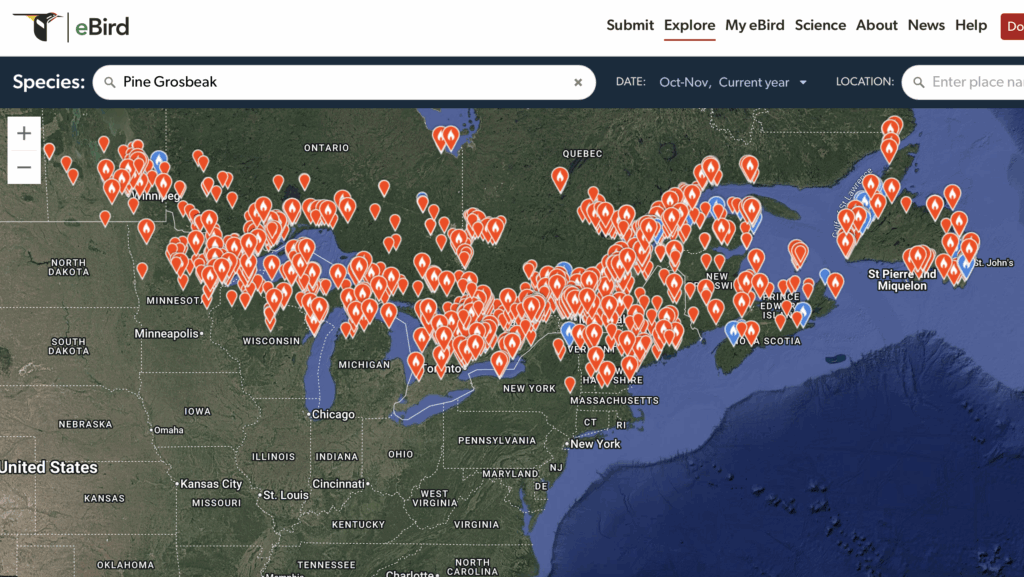
PURPLE FINCH
Winter Finch Forecast Prediction:
Most Purple Finches will migrate south out of Eastern Canada this winter with some making it to the deep southern States. Reports of early movement have been occurring for weeks. Many young finches benefited from the ample food source provided by the widespread spruce budworm outbreaks, and this led to them moving in search of food weeks ago.
At feeders, they prefer black oil sunflower seeds. Away from feeders, this species is known to feed on lilac, ash, and other deciduous seeds during the winter.
Where We’re At Now:
Purple Finches irrupted into the south in good numbers last year as predicted, and it’s looking like, as predicted, there will be modest flight into the southern areas this year as well as birds have now reached the gulf coast states. Look for them to continue to inch their way southward and increase in numbers across the eastern half of the United States with a few lingering in southeastern Canada as well.
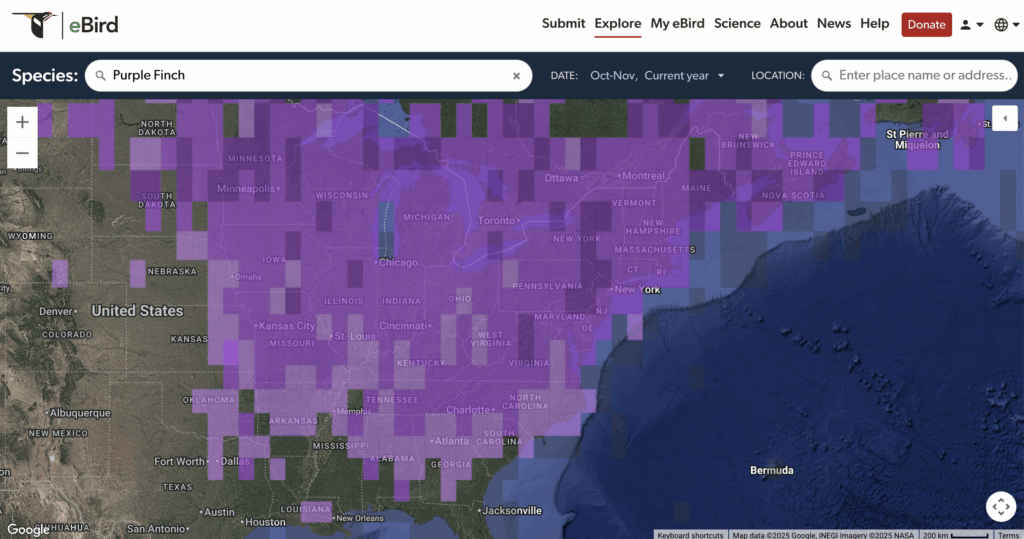
REDPOLL
Winter Finch Forecast Prediction:
Expect a probable strong flight south out of the boreal forest east of Lake Superior southward into the lower great lakes, eastward through northern New York, New England and the Maritime provinces. Many of the Redpolls coming out of the central-western subarctic/arctic regions should gravitate toward the Manitoba westward cone crop. The early and widespread but not unprecedented flight into Northern Ontario eastward to Newfoundland this August is pointing towards a more widespread crop failure of birches and Alders in Northern Quebec. The very poor crop to complete absence of the White Birch and Tamarack crop in areas from Manitoba eastward to central Quebec, plus the below-average alder and swamp birch crops, should force the majority of the redpolls southward once snow covers the weedy fields in the boreal.
Watch for redpolls on birches (including in urban area), in weedy fields and at bird feeders offering nyjer®and black oil sunflower seeds.
In 2024, Common Redpoll, Hoary Redpoll and the Lesser Redpoll in Europe have all been lumped into the same species, now called Redpoll. Genetic work found that a supergene was responsible for the Redpoll plumage differences.
Watch for “Hoaries” in flocks of “Common” Redpolls. See the link below for photos and identification marks of the Redpoll subspecies.
Where We’re At Now:
As predicted Redpolls have made a really nice push in recent weeks into the Great Lakes and are starting to show good signs of pushing into the Northeast as well. Tadoussac and Hawk Ridge have had flights in the 100s to 1000s in the past week, and the birds have finally mostly decided to fly south at Tadoussac. Look for birds to continue to increase across these areas, with hopefully birds increasing in Ohio, Pennsylvania and New Jersey as well. Keep those feeders well stocked with nyjer® and sunflower seed. Looks like southeastern Canada will have plenty of Redpoll fun this winter.
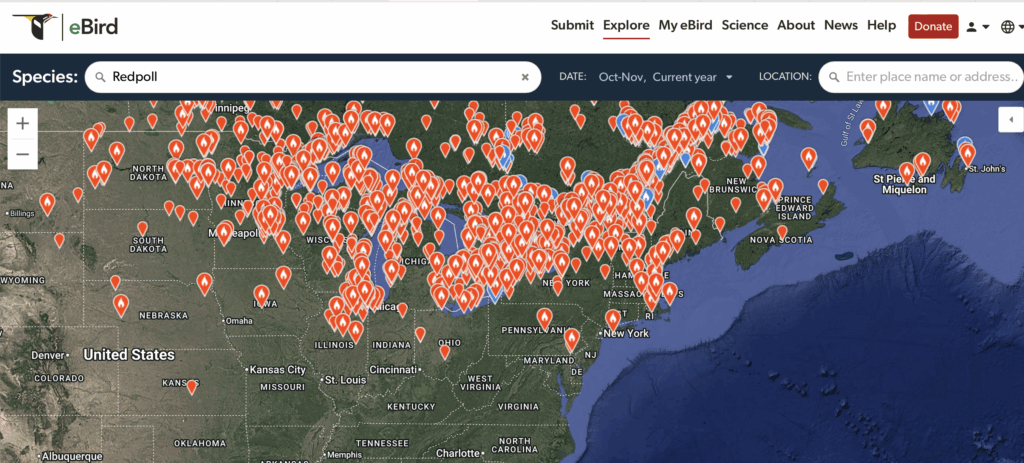
RED CROSSBILL
Winter Finch Forecast Prediction:
There is a good mixed conifer crop throughout the Maritimes provinces and northeastern states westward to upstate New York. Type 12 Red Crossbills are in their usual conifer haunts across the Northeast, and this should continue through much of the winter. A few Type 1 Red Crossbills will be scattered about as well.
There should be more modest numbers from Algonquin Provincial Park over to the upper Great Lakes states. Don’t expect to see much in the way of any irruption from the west (Type 2 being maybe a wild card).
There may be a movement late winter down the coast to Long Island, Cape May, Delaware, and points south, as they sometimes do, as cone crops are depleted as we progress through the winter season.
The Red Crossbill types are usually impossible to identify without recordings of their flight calls. Recordings can be made with a smartphone and identified to type. Matt Young (info@finchnetwork.org) will identify types if you email him your recordings or upload them to an eBird checklist. Recordings uploaded to eBird checklists are deposited in the Macaulay Library. See the link below for Red Crossbill call types.
Where We’re At Now:
Red Crossbills are scattered across southeastern Canada, Northeastern U.S., and to some extent the Great Lakes as well. A majority of these birds are the “Northeastern” Type 12, but there are small flocks of Type 2 around, individual Type 4s, and a some Type 1 as well. There are always a few Type 2 around in the East every year, but many of the Type 2 and likely all of the Type 4, are leftovers from the massive irruptive flight two years ago. Birds in the southern Appalachians are Type 1 and are relatively common in those areas every year like Type 12 is in the Northeastern U.S., Maritimes and Algonquin PP areas. Keep recording Red Crossbills and sending them on to us here at the Finch Research Network. We’ll have a new North American Red Crossbill primer out in the next week or two. Stay tuned.

WHITE-WINGED CROSSBILL
Winter Finch Forecast Prediction:
The Crossbill Pendulum has swung west for the winter of 2025-26. An excellent spruce crop from northeastern Manitoba to Alaska and down the mountains of western Canada should contain the majority of White-winged Crossbills this winter. Flocks were observed leaving the Hudson Bay Lowlands of Northern Ontario, moving westward in June. Most crossbills remaining in the east should gravitate towards the New England-Maritimes spruce crop. Outside of these two spruce crops, expect scattered flocks and individuals randomly moving around the Great Lakes area in search of suitable food sources, including any cone-laden Spruces (including ornamentals) within urban areas.
The difference the presence of a cone crop can make –The author worked six weeks in the boreal forest in Northern Ontario in 2024 and 2025. 2024 had an above average Tamarack crop ripen, which resulted in observing 1100+ crossbills. The same area in 2025 had no cone crop, which resulted in only five crossbills being observed.
Where We’re At Now:
Look for small flocks and individuals to be scattered across southeastern Canada, Great Lakes and New England and NY this winter. As Tyler predicted, this will be a multi-finch species event this winter, and even White-wings should be findable in areas with ornamental conifers and in the usual good southern boreal-like haunts.

PINE SISKIN
Winter Finch Forecast Prediction:
Areas affected by Spruce Budworm infestations provided widespread and bountiful food during the breeding season, but these same areas also have a very poor cone crop for the winter. Siskins that bred in these areas will be on the move.
As seen by band recoveries, Pine Siskins, similar to White-winged Crossbills, will move east or west in search of cone crops. This year, birds will move towards both extensive cone crop areas. But with the widespread and extensive very poor White Spruce and White Birch crop in the eastern boreal forest, there should be a moderate to possibly strong flight of siskins southward, possibly as far south the mid Atlantic states.
An above-average Eastern White Cedar crop around the lower Great Lakes will attract some flocks for the winter.
This entertaining species prefers nyjer® seeds in silo or sock feeders.
Where We’re At Now:
There was a very good movement reported this fall at Tadoussac, Quebec and there are flocks of siskin across the northern states and southeastern Canada areas as well. Texas also has had a nice influx of birds, but some of these could be coming from the Rockies as well. We didn’t think this would be a big siskin irruption, but look for the irruption to continue to slowly pick up steam as winter progresses. Siskins will be findable if you get out birding and likely will increase at feeders, along with redpolls, as winter and some snow hopefully blanket the area. 🙂 Birds will continue to increase across the southern states as well where numbers have been mostly ones and twos.

EVENING GROSBEAK
Winter Finch Forecast Prediction:
Like the other budworm-loving finches, Evening Grosbeaks were widespread in these areas, rearing families on this abundant food source. Food sources used post-budworm, like cherry species, ash, and mountain ash, had poor crops over widespread areas.
There should be a moderate flight of Evening Grosbeaks southward this fall. Depending on the direction and timing when Evening Grosbeaks come out of the boreal forest, some flocks may winter further south of their usual areas. The eastern cone crop area should hold wintering flocks in southern Quebec, the Maritime provinces, New England states, and New York this winter. A few birds likely make it to Pennsylvania and perhaps the higher elevations of the Mid-Atlantic States as well.
Evening Grosbeaks in northwestern Ontario should move out of the boreal forest and look for feeders in towns or other suitable food sources.
At platform feeders, Evening Grosbeaks prefer black oil sunflower seeds. Evening Grosbeaks will look away from feeders for maple and ash trees still holding seeds. See the links section below for Evening Grosbeak call types eBird article, and The Evening Grosbeak Road to Recovery Project.
Where We’re At Now:
The darling of the finch group for many. It has been a moderate flight as predicted, and this marks back-to back flight years, albeit last year’s flight was actually smaller than this year’s flight. Birds were earlier in arriving this year, and in bigger flocks. A few birds have already arrived in the Mid-Atlantic areas of Maryland and the Virginias. Flocks should be relatively common in hamlets with feeders and higher elevational areas with feeders across southeastern Canada, the Great Lakes and northeastern U.S. this winter. Look for numbers to slowly increase a bit along the southern edge of the irruption with a few birds possibly making it to North Carolina. Keep those platform, tray and hopper feeders stocked with black oil and striped sunflower seeds, the preferred seeds for the “grocery-beak”.
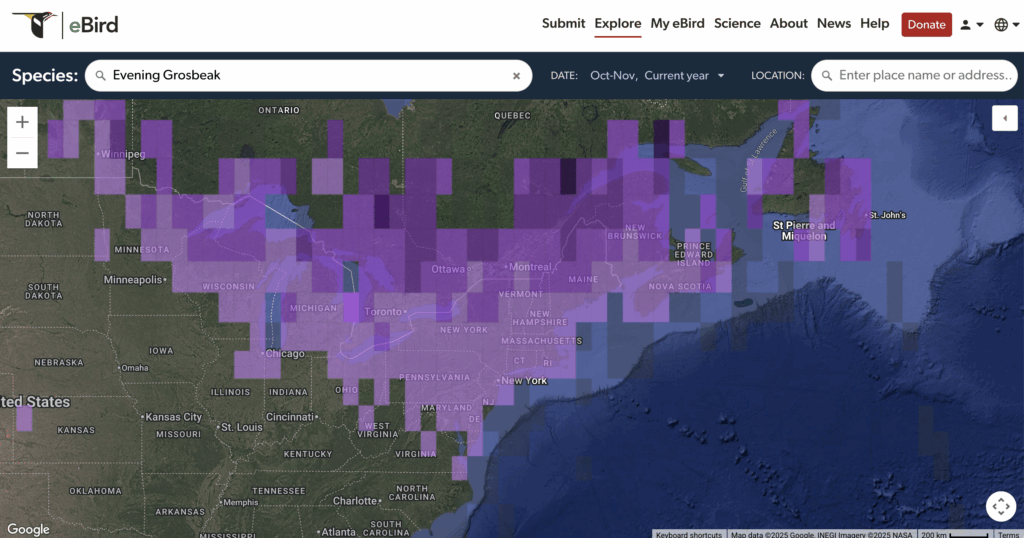
RED-BREASTED NUTHATCH
Winter Finch Forecast Prediction:
his species has been irrupting south since mid-August and continues to irrupt. Individuals have made it as far as the Alabama Gulf Coast. With poor cone crops in the eastern boreal forest, expect this species to continue to move southward. At feeders, this species prefers black oil seeds, suet, and peanuts.
Where We’re At Now:
Ah, the honorary finch and harbinger of finch irruptions — The Red-breasted Nuthatch has pushed deep into the south in numbers with lots of sightings across the east all the way to the Gulf Coast. Look for birds to be common across the east this year! What a delightful species!
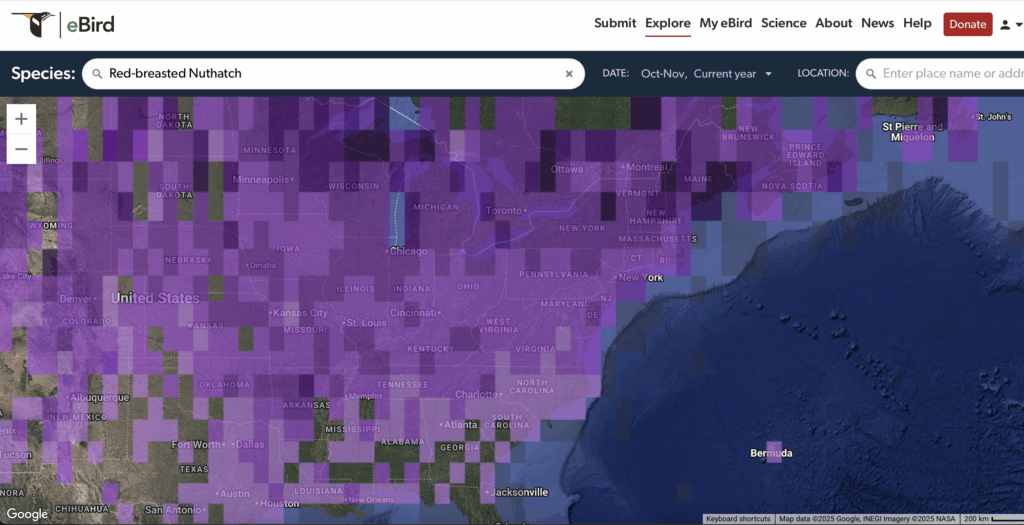
BOHEMIAN WAXWING
Winter Finch Forecast Prediction:
Bohemian Waxwings in Manitoba westward should remain close to the boreal and mountain forests this winter. Most bohemians east of Manitoba will likely be on the move, looking for suitable fruit crops. With the native mountain ash crop poor east of Lake Superior, bohemians should be moving into their traditional areas from Central Ontario eastward into the Maritime Provinces and northern New England by early winter. Some individuals should show by mid-fall, possibly hidden within Cedar Waxwing flocks.
Areas of the lower Great Lakes have experienced drought conditions since late summer, and scattered berry crop failures have been noticed. This may force Bohemian Waxwings to roam further than their traditional wintering ranges in search of food over the latter part of winter.
Bohemians coming south to forage on reliable annual crops of abundant Buckthorn (Rhamnus) berries, Red Cedar, wild grape, will also forage on planted European Mountain-ash berries and ornamental crabapples within settlements.
Where We’re At Now:
Again, as predicted, Bohemians have made a nice and early push across the usual areas. A few have even already been seen in eastern Massachusetts and along the lakeshores in New York. As Tyler predicted, frugivores, Pine Grosbeak and Bohemian Waxwing could outperform the forecast.
Time will tell. Stay tuned here for more as winter progresses and we get into the Audubon Christmas Bird Count season.
Cover Photo Ryan Brady

The Finch Research Network (FiRN) is a nonprofit, and was granted 501c3 status in 2020. We are a co-lead on the International Evening Grosbeak Road to Recovery Project, and have funded almost $22,000 to go towards research, conservation and education for finch projects in the last couple years. FiRN is committed to researching and protecting these birds like the Evening Grosbeak, Purple Finch, Crossbills, Rosy-finches, and Hawaii’s finches the honeycreepers.
If you have been enjoying all the finch forecasts, blogs and identifying of Evening Grosbeak and Red Crossbill call types (20,000+ recordings listened to and identified), redpoll subspecies and green morph Pine Siskins FiRN has helped with over the years, please think about supporting our efforts and making a small donation at the donate link below. The Evening Grosbeak Project is in need of continued funding to help keep it going.
Donate – FINCH RESEARCH NETWORK (finchnetwork.org)
Book Link
For help with Finch ID and much much more, here is a link to the exciting and newly released Stokes Guide to Finches of the United States and Canada: https://www.amazon.com/Stokes-Finches-United-States-Canada/dp/0316419931
Shirt Link
For a commemorative Winter Finch Forecast shirt or a newly released Goldfinch shirt with all 3 Goldfinch species that makes for a great holiday present, see here: https://finchnetwork.org/shop
Please think about joining Finch Research Network iNaturalist Projects:
Winter Finch Food Assessment Project/Become a Finch Forecaster:https://finchnetwork.org/the-finch-food-assessment-become-a-finch-forecaster
Evening Grosbeak Foraging Project: https://www.inaturalist.org/projects/evening-grosbeak-foraging
Evening Grosbeak Window Kill Project: https://www.inaturalist.org/projects/evening-grosbeak-window-collisions
Red Crossbill Foraging Project: https://www.inaturalist.org/projects/red-crossbill-foraging-in-north-america

